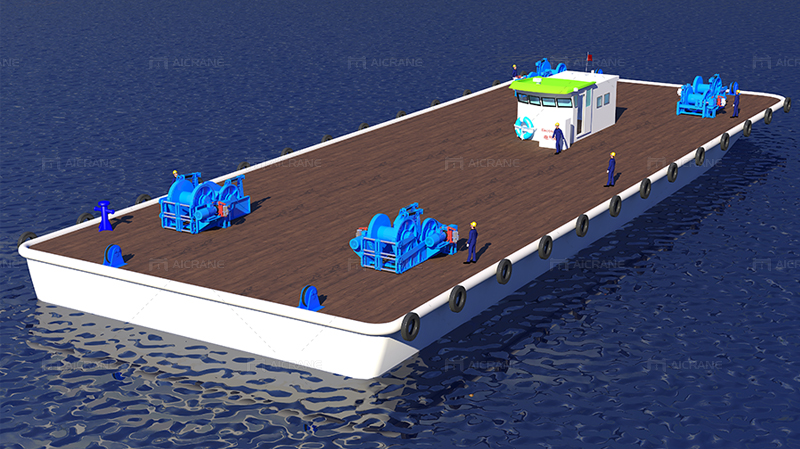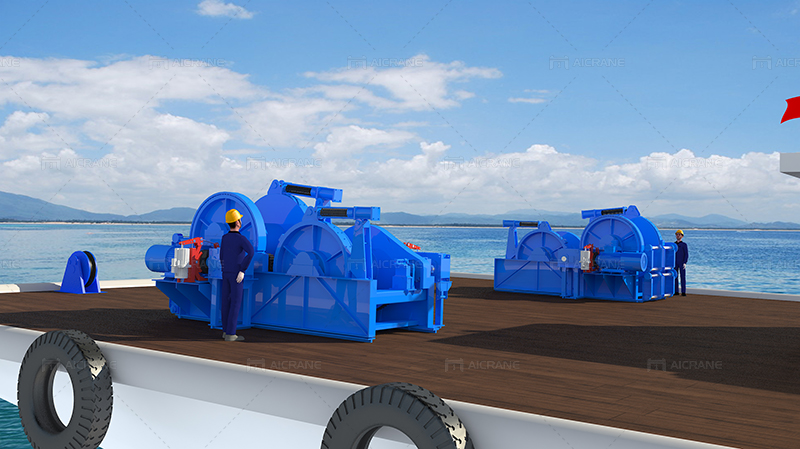Electric mooring winches have emerged as indispensable tools in the maritime sector, offering enhanced efficiency and precision in securing vessels to docks or other structures. Despite their numerous advantages, the operation of electric mooring winches is not immune to challenges. This article delves into the common issues faced during the operation of these systems, shedding light on the factors that can impact their reliability and performance.

Power Supply Fluctuations:
One of the foremost challenges in electric mooring winch operation is susceptibility to power supply fluctuations. These fluctuations can be caused by irregular voltage or power interruptions, leading to erratic performance. The inconsistency in power supply can compromise the winch’s ability to smoothly and safely handle mooring operations, potentially resulting in delays or safety hazards.
To mitigate this challenge, it is crucial to implement robust power supply systems and consider incorporating voltage regulation mechanisms into the winch design. These measures can help stabilize the power input, ensuring a more reliable and consistent operation.
Overheating:
Similar to other electrical machinery, electric mooring winches are prone to overheating. Continuous operation without adequate cooling mechanisms can lead to elevated temperatures, compromising the winch’s components and overall structural integrity. Overheating not only reduces the lifespan of the equipment but also poses a potential safety risk.
Effective cooling systems, such as fans or liquid cooling, should be integrated into the design to dissipate heat efficiently. Regular monitoring of temperature levels and implementing automatic shutdown mechanisms in case of overheating can further safeguard against this challenge.
Maintenance Requirements:
Regular maintenance is paramount for the optimal performance of electric mooring winches. However, challenges arise when maintenance is neglected or not conducted according to recommended schedules. Wear and tear on crucial components can occur, decreasing efficiency and increasing the likelihood of malfunctions during critical operations.
To address this challenge, a comprehensive maintenance schedule should be established, covering routine inspections, lubrication, and replacement of worn-out parts. Proactive maintenance not only ensures the longevity of the equipment but also minimizes the risk of unexpected failures.
Environmental Conditions:
Electric mooring winches often operate in harsh environmental conditions, including extreme temperatures, heavy rain, and exposure to saltwater. These conditions can accelerate corrosion and environmental stress, impacting the reliability of the winch.
To overcome environmental challenges, manufacturers should employ corrosion-resistant materials and protective coatings in the winch construction. Additionally, regular inspections and preventive measures, such as freshwater rinses and corrosion inhibitors, can help mitigate the impact of harsh environments on the equipment.

Load Variability:
Electric mooring winches must contend with the variability of loads based on the size and weight of different vessels. Managing this variability requires sophisticated control systems to ensure a consistent and safe mooring process. Challenges arise when the control systems are not adequately equipped to handle these variations, leading to operational inefficiencies.
Advanced load sensing and control technologies should be integrated into the mooring winch system to adapt to changing loads dynamically. This ensures that the winch can adjust its operations in real-time, providing a stable and secure mooring process regardless of the vessel’s size or weight.
Braking System Reliability:
The braking system is a critical safety component in mooring winches, preventing uncontrolled movements and ensuring the stability of the vessel during mooring operations. Challenges arise when the braking system fails to engage or disengage properly, leading to potential accidents.
To address this challenge, regular testing and maintenance of the braking system are essential. Emergency braking mechanisms and redundant systems should be in place to provide fail-safe measures in case of any issues with the primary braking system.
Control System Malfunctions:
Electric mooring winches rely on advanced control systems for precise operation. Malfunctions or errors in these systems can lead to operational disruptions, potentially compromising safety and efficiency during mooring operations.
To mitigate the risk of control system malfunctions, thorough testing and regular software updates should be conducted. Additionally, incorporating manual override options allows operators to take control in case of system failures, ensuring a safe and effective response.
Integration with Vessel Systems:
Ensuring seamless integration with other vessel systems, such as navigation and communication systems, can be a challenge. Compatibility issues may arise, requiring thorough testing and adjustment to achieve optimal performance.
To overcome integration challenges, manufacturers should collaborate with vessel system providers to establish standardized communication protocols. This ensures interoperability and facilitates a smoother integration process, reducing the risk of communication errors and system conflicts.
Operational Training:
Adequate training for personnel operating electric mooring winches is crucial. Challenges can arise when operators lack the necessary skills and knowledge to handle the equipment, potentially leading to operational errors and safety risks.
Comprehensive training programs should be implemented to familiarize operators with the functionalities of electric mooring winches. This includes hands-on training, simulations, and continuous education to keep operators updated on the latest technologies and operational best practices.
Cost Considerations:
The initial investment and maintenance costs associated with electric mooring winches can be a challenge for some operators. Striking a balance between cost-effectiveness and the need for high-quality, reliable equipment is an ongoing consideration.
To address cost challenges, a thorough cost-benefit analysis should be conducted during the procurement phase. Evaluating the long-term benefits, including increased efficiency, reduced downtime, and enhanced safety, can justify the upfront costs associated with marine winches.
Conclusion:
In conclusion, electric mooring winches play a pivotal role in modern maritime operations, offering enhanced efficiency and safety. While challenges exist, proactive measures in design, maintenance, and operational practices can significantly mitigate these issues. As technology continues to advance, addressing these challenges will become increasingly critical, ensuring that electric mooring winches remain reliable and effective tools for the maritime industry.